Samsung CLX-3170 User Manual
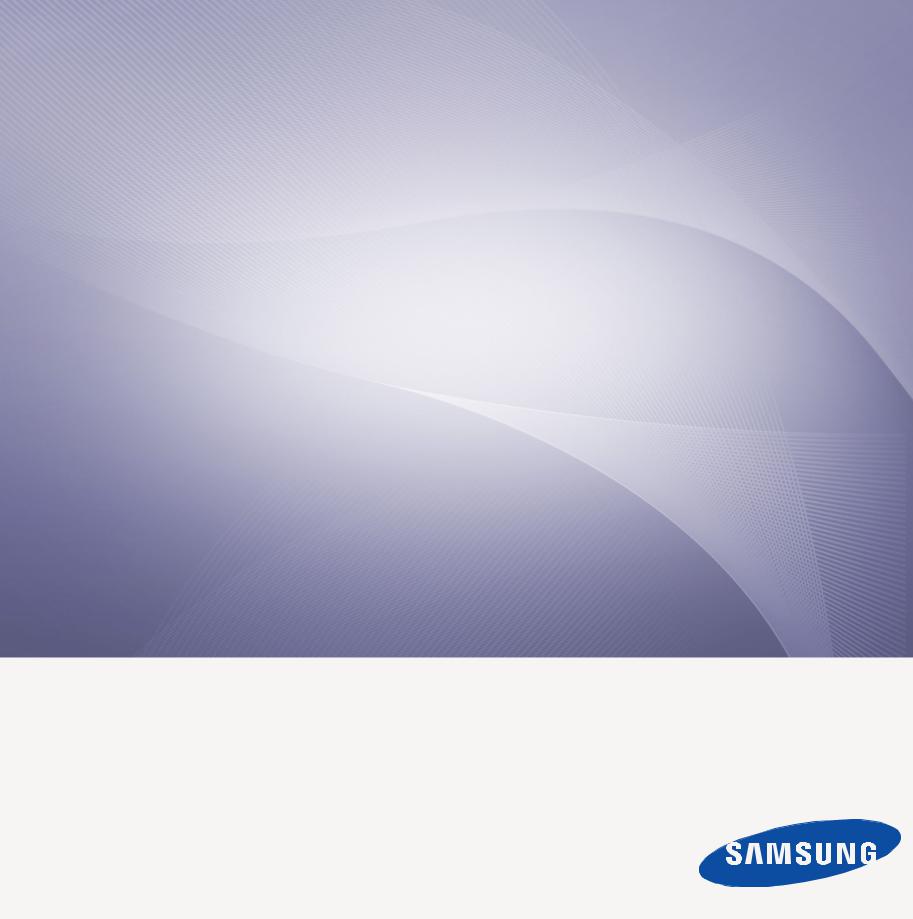
CLX-3170 Series
Multi Functional Printer
User’s Guide
imagine the possibilities
Thank you for purchasing a Samsung product. To receive a more complete service, please register your product at
www.samsung.com/global/register
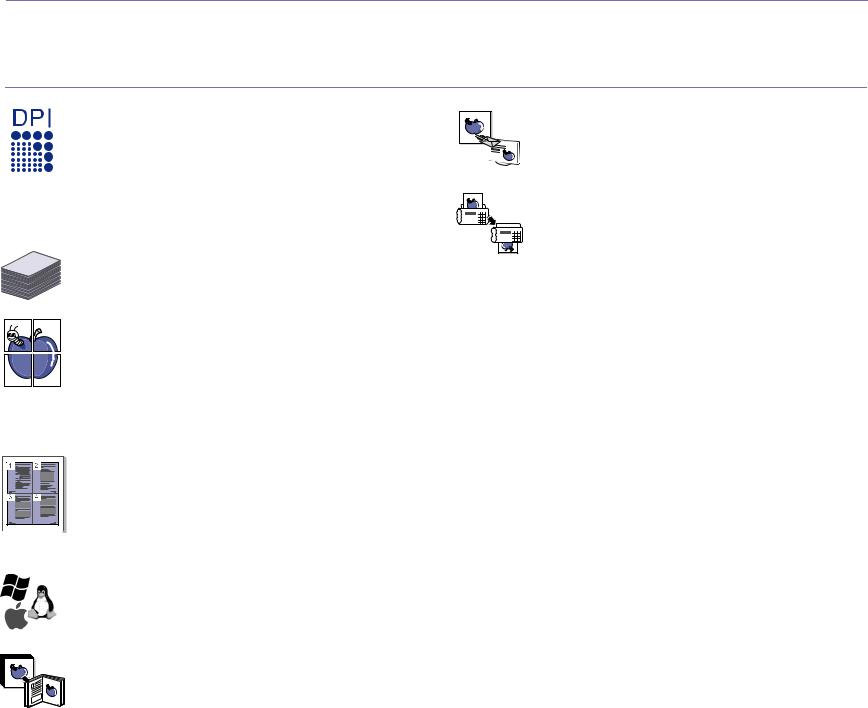
features of your new laser product
Your new machine is equipped with a number of special features that improve the quality of the documents you print. With the machine, you can:
SPECIAL FEATURES
Print with excellent quality and speed
•You can print in a full range of colors using cyan, magenta,
yellow, and black.
• You can print with a resolution of up to 2400 x 600 dpi. See
Software section.
•Your machine prints A4-sized paper at up to 16 ppm and letter-sized paper at up to 17 ppm. In Color mode, your machine prints A4-sized or letter sized paper at up to
4 ppm.
Handle many different types of printable material
•The 150-sheet tray supports plain paper in various sizes: letterhead, envelopes, labels, custom-sized media, postcards, and heavy paper.
Create professional documents
• Print Watermarks. You can customize your documents with words, such as “Confidential”. See Software section.
• Print Posters. The text and pictures of each page of your document are magnified and printed across the sheet of paper and can then be taped together to form a poster. See
Software section.
•You can use preprinted forms and letterhead with plain paper. See Software section.
Save time and money
• To save paper, you can print multiple pages on one single sheet of paper.
• This machine automatically conserves electricity by substantially reducing power consumption when not in use.
 • To save paper, you can print on both sides of the paper (double-sided printing). See Software section.
• To save paper, you can print on both sides of the paper (double-sided printing). See Software section.
Print in various environments
•You can print with Windows 2000/XP/2003/Vista as well as
Linux and Macintosh systems.
•Your machine is equipped with a USB interface and a network interface.
Copy originals in several formats
• Your machine can print multiple image copies from the original document on a single page.
• There are special functions to erase catalog and newspaper background.
•The print quality and image size may be adjusted and enhanced at the same time.
Scan the originals and send it right away
•Scan in color and use the precise compressions of JPEG, TIFF and PDF formats.
•Quickly scan and send files to multiple destinations using Networks scanning.
Set a specific time to transmit a Fax
•You can specify a certain time to transmit the fax and also send the fax to several stored destinations.
•After the transmission, the machine may print out the fax reports according to the setting.
2_Features of your new laser product

FEATURES BY MODELS
The machine is designed to support all of your document needs – from printing and copying, to more advanced networking solutions for your business. Basic features of this machine include:
FEATURES |
CLX-3170FN |
CLX-3175FN |
CLX-3175FW |
USB 2.0
USB Memory Interface
PictBridge
ADF (Automatic Document Feeder)
Network Interface Ethernet 10/100 Base TX wired LAN
Network interface 802.11b/g wireless LAN
FAX
( : Included, Blank: Not Available)
ABOUT THIS USER’S GUIDE
This user’s guide provides information about basic understanding of the machine as well as detailed explanation on each step during the actual usage. Both novice users and professional users can refer to this guide for installing and using the machine.
Some terms in this guide are used interchangeably, as below:
•Document is synonymous with original.
•Paper is synonymous with media, or print media. Following table offers the conventions of this guide:
CONVENTION |
DESCRIPTION |
EXAMPLE |
|
|
|
Bold |
Used for texts on the display or actual prints on the machine. |
Start |
|
|
|
Note |
Used to provide additional information or detailed specification of the machine |
The date format may differ from |
|
function and feature. |
country to country |
Caution |
Used to give users information to protect the machine from possible mechanical |
Do not touch the green underside of |
|
damage or malfunction. |
the toner cartridge. |
|
|
|
Footnote |
Used to provide more detailed information on certain words or a phrase. |
a. pages per minute |
|
|
|
(See page 1 for more |
Used to guide users to the reference page for the additional detailed information. |
(See page 1 for more information) |
information) |
|
|
|
|
|
Features of your new laser product_3
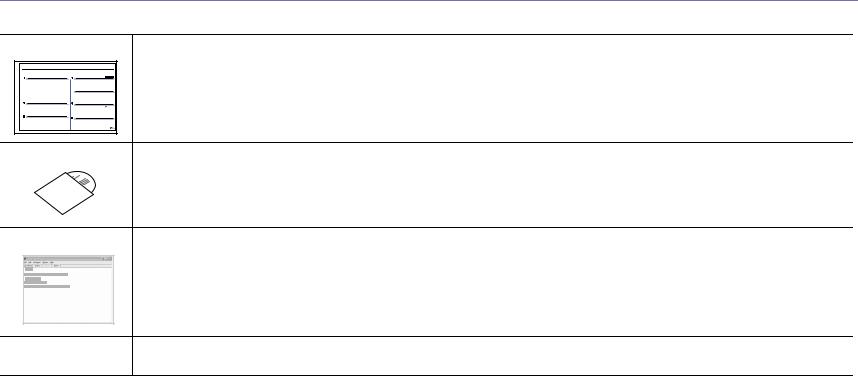
FINDING MORE INFORMATION
You can find information for setting up and using your machine from the following resources, either as a print-out or onscreen.
Quick Install Guide Provides information on setting up your machine and this requires that you follow the instructions in the guide to prepare the machine.
Online User’s Guide Provides you with step-by-step instructions for using your machine’s full features, and contains information for maintaining your machine, troubleshooting, and installing accessories.
This user’s guide also contains a Software section to provide you with information on how to print documents with your machine in various operating systems, and how to use the included software utilities.
Printer Driver Help Provides you with help information on printer driver properties and instructions for setting up the properties for printing. To access a printer driver help screen, click Help from the printer properties dialog box.
Samsung website If you have Internet access, you can get help, support, printer drivers, manuals, and order information from the Samsung website, www.samsungprinter.com.
4_Features of your new laser product

safety information
IMPORTANT SAFETY SYMBOLS AND PRECAUTIONS
What the icons and signs in this user’s guide mean:
Hazards or unsafe practices that may result in severe personal injury or death.
WARNING
Hazards or unsafe practices that may result in minor personal injury or property damage.
CAUTION
To reduce the risk of fire, explosion, electric shock, or personal injury when using your laser MFP, follow these basic safety
precautions:
CAUTION
Do NOT attempt.
Do NOT disassemble.
Do NOT touch.
Follow directions explicitly.
Unplug the power plug from the wall socket.
Make sure the MFP is grounded to prevent electric shock.
Call the service center for help.
These warning signs are here to prevent injury to you and others. Follow them explicitly. After reading this section, keep it in a safe place for future reference.
1.Read and understand all instructions.
2.Use common sense whenever operating electrical appliances.
3.Follow all warnings and instructions marked on the machine and in the literature accompanying the machine.
4.If an operating instruction appears to conflict with safety information, heed the safety information. You may have misunderstood the operating instruction. If you cannot resolve the conflict, contact your sales or service representative for assistance.
5.Unplug the machine from the AC wall socket and/or telephone jack before cleaning. Do not use liquid or aerosol cleaners. Use only a damp cloth for cleaning.
6.Do not place the machine on an unstable cart, stand or table. It may fall, causing serious damage.
7.Your machine should never be placed on, near or over a radiator, heater, air conditioner or ventilation duct.
8.Do not allow anything to rest on the power. Do not locate your machine where the cords will be abused by persons walking on them.
9.Do not overload wall outlets and extension cords. This can diminish performance, and may result in the risk of fire or electric shock.
10.Do not allow pets to chew on the AC power, telephone or PC interface cords.
11.Never push objects of any kind into the machine through case or cabinet openings. They may touch dangerous voltage points, creating a risk of fire or shock. Never spill liquid of any kind onto or into the machine.
12. To reduce the risk of electric shock, do not disassemble the machine. Take it to a qualified service technician when repair work is required. Opening or removing covers may expose you to dangerous voltages or other risks. Incorrect reassembly could cause electric shock when the unit is subsequently used.
Safety information_5
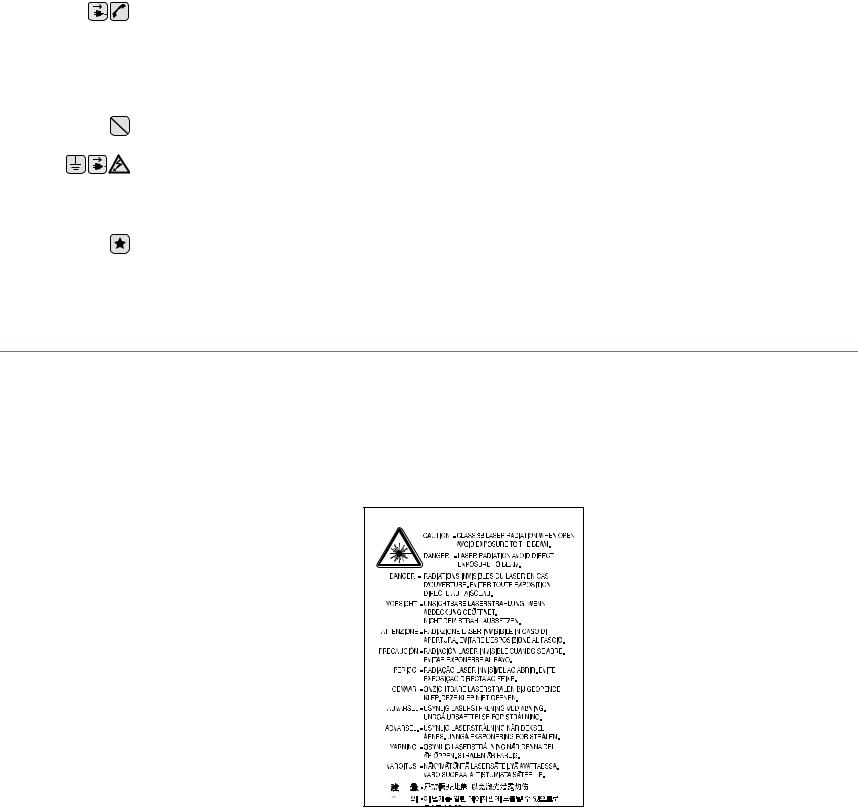
13. Unplug the machine from the telephone jack, PC and AC wall outlet and refer servicing to qualified service personnel under the following conditions:
•When any part of the power cord, plug or connecting cable is damaged or frayed.
•If liquid has been spilled into the machine.
•If the machine has been exposed to rain or water.
•If the machine does not operate properly after instructions have been followed.
•If the machine has been dropped, or the cabinet appears damaged.
•If the machine exhibits a sudden and distinct change in performance.
14.Adjust only those controls covered by the operating instructions. Improper adjustment of other controls may result in damage, and may require extensive work by a qualified service technician to restore the machine to normal operation.
15.Avoid using this machine during a lightning storm. There may be a remote risk of electric shock from lightning. If possible, unplug the
AC power and telephone cord for the duration of the lightning storm.
16.The Power cord supplied with your machine should be used for safe operation. If you are using a cord which is longer than 2 m with 110 V machine, then it should be 16 AWGa or bigger.
17.Use only No.26 AWG or larger telephone line cord.
18.SAVE THESE INSTRUCTIONS
19.This machine can be operated only in the country you have purchased. (Due to different voltage, telecommunication configuration and etc.)
a.AWG: American Wire Gauge
LASER SAFETY STATEMENT
The printer is certified in the U.S. to conform to the requirements of DHHS 21 CFR, chapter 1 Subchapter J for Class I(1) laser products, and elsewhere is certified as a Class I laser product conforming to the requirements of IEC 825.
Class I laser products are not considered to be hazardous. The laser system and printer are designed so there is never any human access to laser radiation above a Class I level during normal operation, user maintenance or prescribed service condition.
WARNING
Never operate or service the printer with the protective cover removed from Laser/Scanner assembly. The reflected beam, although invisible, can damage your eyes.
When using this product, these basic safety precautions should always be followed to reduce risk of fire, electric shock, and injury to persons:
6_Safety information
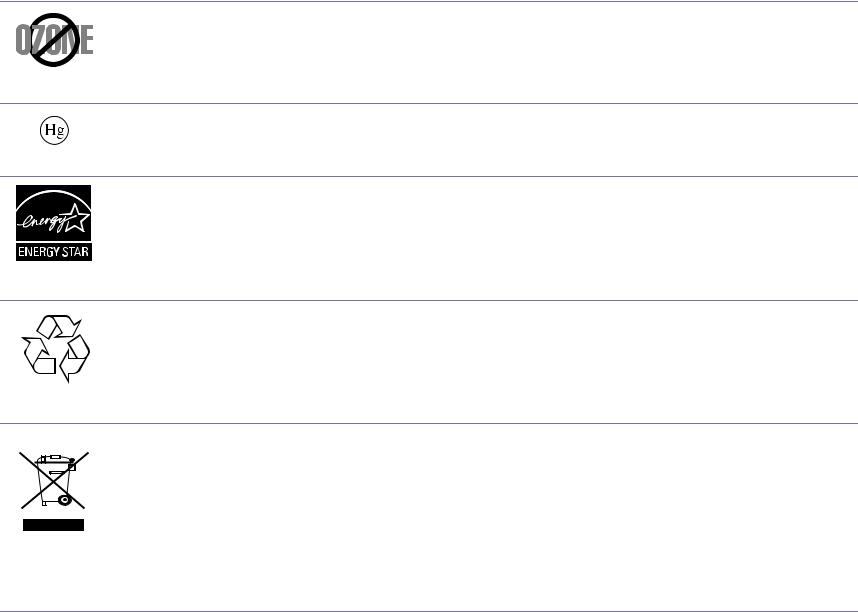
OZONE SAFETY
During normal operation, this machine produces ozone. The ozone produced does not present a hazard to the operator. However, it is advisable that the machine be operated in a well ventilated area.
If you need additional information about ozone, request your nearest Samsung dealer.
MERCURY SAFETY
Contains Mercury, Dispose According to Local, State or Federal Laws.(U.S.A. only)
POWER SAVER
This printer contains advanced energy conservation technology that reduces power consumption when it is not in active use. When the printer does not receive data for an extended period of time, power consumption is automatically lowered. ENERGY STAR and the ENERGY STAR mark are registered U.S. marks.
For more information on the ENERGY STAR program see http://www.energystar.gov
RECYCLING
Recycle or dispose of the packaging material for this product in an environmentally responsible manner.
CORRECT DISPOSAL OF THIS PRODUCT (WASTE ELECTRICAL & ELECTRONIC EQUIPMENT)
(Applicable in the European Union and other European countries with separate collection systems)
This marking shown on the product or its literature, indicates that it should not be disposed with other household wastes at the end of its working life. To prevent possible harm to the environment or human health from uncontrolled waste disposal, separate this from other types of wastes and recycle it responsibly to promote the sustainable reuse of material resources.
Household users should contact either the retailer where they purchased this product, or their local government office, for details of where and how they can take this item for environmentally safe recycling.
Business users should contact their supplier and check the terms and conditions of the purchase contract. This product should not be mixed with other commercial wastes for disposal.
RADIO FREQUENCY EMISSIONS
FCC Information to the User
This device complies with Part 15 of the FCC Rules. Operation is subject to the following two conditions:
•This device may not cause harmful interference, and
•This device must accept any interference received, including interference that may cause undesired operation.
This equipment has been tested and found to comply with the limits for a Class B digital device, pursuant to Part 15 of the FCC Rules. These limits are designed to provide reasonable protection against harmful interference in a residential installation. This equipment generates, uses and can radiate radio frequency energy and, if not installed and used in accordance with the instructions, may cause harmful interference to radio communications. However, there is no guarantee that interference will not occur in a particular installation. If this equipment does cause harmful interference to radio or television reception, which can be determined by turning the equipment off and on, the user is encouraged to try to correct the interference by one or more of the following measures:
•Reorient or relocate the receiving antenna.
•Increase the separation between the equipment and receiver.
•Connect the equipment into an outlet on a circuit different from that to which the receiver is connected.
Safety information_7

•Consult the dealer or experienced radio TV technician for help.
Change or modifications not expressly approved by the manufacturer responsible for compliance could void the user's authority to operate the equipment.
Canadian Radio Interference Regulations
This digital apparatus does not exceed the Class B limits for radio noise emissions from digital apparatus as set out in the interference-causing equipment standard entitled “Digital Apparatus”, ICES-003 of the Industry and Science Canada.
Cet appareil numérique respecte les limites de bruits radioélectriques applicables aux appareils numériques de Classe B prescrites dans la norme sur le matériel brouilleur: “Appareils Numériques”, ICES-003 édictée par l’Industrie et Sciences Canada.
UNITED STATES OF AMERICA
Federal Communications Commission (FCC)
Intentional emitter per FCC Part 15
Low power, Radio LAN type devices (radio frequency (RF) wireless communication devices), operating in the 2.4 GHz/5 GHz Band, may be present (embedded) in your printer system. This section is only applicable if these devices are present. Refer to the system label to verify the presence of wireless devices.
Wireless devices that may be in your system are only qualified for use in the United States of America if an FCC ID number is on the system label.
The FCC has set a general guideline of 20 cm (8 inches) separation between the device and the body, for use of a wireless device near the body (this does not include extremities). This device should be used more than 20 cm (8 inches) from the body when wireless devices are on. The power output of the wireless device (or devices), which may be embedded in your printer, is well below the RF exposure limits as set by the FCC.
This transmitter must not be collocated or operation in conjunction with any other antenna or transmitter.
Operation of this device is subject to the following two conditions:(1) This device may not cause harmful interference, and(2) this device must accept any interference received, including interference that may cause undesired operation of the device.
Wireless devices are not user serviceable. Do not modify them in any way. Modification to a wireless device will void the authorization to use it. Contact manufacturer for service.
FCC Statement for Wireless LAN use:
While installing and operating this transmitter and antenna combination the radio frequency exposure limit of 1mW/cm2 may be exceeded at distances close to the antenna installed. Therefore, the user must maintain a minimum distance of 20cm from the antenna at all times. This device cannot be colocated with another transmitter and transmitting antenna.
FAX BRANDING
The Telephone Consumer Protection Act of 1991 makes it unlawful for any person to use a computer or other electronic device to send any message via a telephone facsimile machine unless such message clearly contains in a margin at the top or bottom of each transmitted page or on the first page of the transmission the following information:
(1)the date and time of transmission
(2)identification of either business, business entity or individual sending the message; and
(3)telephone number of either the sending machine, business, business entity or individual.
The Telephone Company may make changes in its communications facilities, equipment operations or procedures where such action is reasonably required in the operation of its business and is not inconsistent with the rules and regulations in FCC Part 68. If such changes can be reasonably expected to render any customer terminal equipment incompatible with telephone company communications facilities, or require modification or alteration of such terminal equipment, or otherwise materially affect its use or performance, the customer shall be given adequate notice in writing, to allow the customer an opportunity to maintain uninterrupted service
8_Safety information

RINGER EQUIVALENCE NUMBER
The Ringer Equivalence Number and FCC Registration Number for this machine may be found on the label located on the bottom or rear of the machine. In some instances you may need to provide these numbers to the telephone company.
The Ringer Equivalence Number (REN) is a measure of the electrical load placed on the telephone line, and is useful for determining whether you have “overloaded” the line. Installing several types of equipment on the same telephone line may result in problems making and receiving telephone calls, especially ringing when your line is called. The sum of all Ringer Equivalence Numbers of the equipment on your telephone line should be less than five in order to assure proper service from the telephone company. In some cases, a sum of five may not be usable on your line. If any of your telephone equipment is not operating properly, you should immediately remove it from your telephone line, as it may cause harm to the telephone network.
FCC Regulations state that changes or modifications to this equipment not expressly approved by the manufacturer could void the user’s authority to operate this equipment. In the event that terminal equipment causes harm to the telephone network, the telephone company should notify the customer that service may be stopped. However, where prior notice is impractical, the company may temporarily cease service, providing that they:
a)promptly notify the customer.
b)give the customer an opportunity to correct the equipment problem.
c)inform the customer of the right to bring a complaint to the Federal Communication Commission pursuant to procedures set out in FCC Rules and Regulations Subpart E of Part 68.
You should also know that:
•Your machine is not designed to be connected to a digital PBX system.
•If you intend to use a computer modem or fax modem on the same phone line as your machine, you may experience transmission and reception problems with all the equipment. It is recommended that no other equipment, except for a regular telephone, share the line with your machine.
•If your area experiences a high incidence of lightning or power surges, we recommend that you install surge protectors for both the power and the telephone lines. Surge protectors can be purchased from your dealer or telephone and electronic specialty stores.
•When programming emergency numbers and/or making test calls to emergency numbers, use a non-emergency number to advise the emergency service dispatcher of your intentions. The dispatcher will give you further instructions on how to actually test the emergency number.
•This machine may not be used on coin service or party lines.
•This machine provides magnetic coupling to hearing aids.
You may safely connect this equipment to the telephone network by means of a standard modular jack, USOC RJ-11C.
Safety information_9
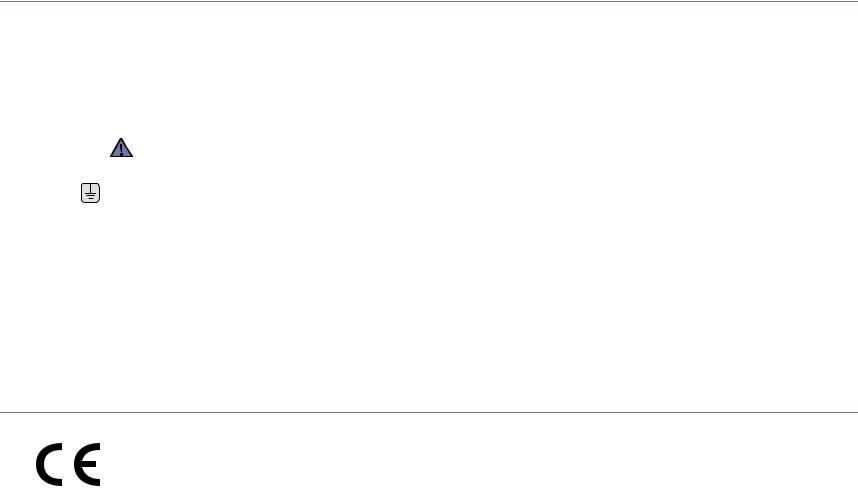
REPLACING THE FITTED PLUG (FOR UK ONLY)
Important
The mains lead for this machine is fitted with a standard (BS 1363) 13 amp plug and has a 13 amp fuse. When you change or examine the fuse, you must re-fit the correct 13 amp fuse. You then need to replace the fuse cover. If you have lost the fuse cover, do not use the plug until you have another fuse cover.
Contact the people from you purchased the machine.
The 13 amp plug is the most widely used type in the UK and should be suitable. However, some buildings (mainly old ones) do not have normal 13 amp plug sockets. You need to buy a suitable plug adaptor. Do not remove the moulded plug.
If you cut off the moulded plug, get rid of it straight away.
You cannot rewire the plug and you may receive an electric shock if you plug it into a socket.
Important warning:
You must earth this machine.
The wires in the mains lead have the following color code:
•Green and Yellow: Earth
•Blue: Neutral
•Brown: Live
If the wires in the mains lead do not match the colors marked in your plug, do the following:
You must connect the green and yellow wire to the pin marked by the letter “E” or by the safety ‘Earth symbol’ or colored green and yellow or green.
You must connect the blue wire to the pin which is marked with the letter “N” or colored black. You must connect the brown wire to the pin which is marked with the letter “L” or colored red. You must have a 13 amp fuse in the plug, adaptor, or at the distribution board.
DECLARATION OF CONFORMITY (EUROPEAN COUNTRIES)
Approvals and Certifications
The CE marking applied to this product symbolizes Samsung Electronics Co., Ltd. Declaration of Conformity with the following applicable 93/ 68/EEC Directives of the European Union as of the dates indicated:
January 1, 1995: Council Directive 2006/95/EC Approximation of the laws of the member states related to low voltage equipment. January 1, 1996: Council Directive 2004/108/EC (92/31/EEC), approximation of the laws of the Member States related to electromagnetic compatibility.
March 9, 1999: Council Directive 1999/5/EC on radio equipment and telecommunications terminal equipment and the mutual recognition of their conformity. A full declaration, defining the relevant Directives and referenced standards can be obtained from your Samsung Electronics Co., Ltd. representative.
EC Certification
Certification to 1999/5/EC Radio Equipment & Telecommunications Terminal Equipment Directive (FAX)
This Samsung product has been self-certified by Samsung for pan-European single terminal connection to the analogue public switched telephone network (PSTN) in accordance with Directive 1999/5/EC. The product has been designed to work with the national PSTNs and compatible PBXs of the European countries:
In the event of problems, you should contact the Euro QA Lab of Samsung Electronics Co., Ltd. in the first instance.
The product has been tested against TBR21. To assist in the use and application of terminal equipment which complies with this standard, the European Telecommunication Standards Institute (ETSI) has issued an advisory document (EG 201 121) which contains notes and additional requirements to ensure network compatibility of TBR21 terminals. The product has been designed against, and is fully compliant with, all of the relevant advisory notes contained in this document.
10_Safety information
European Radio Approval Information
(for products fitted with EU-approved radio devices)
Low power, Radio LAN type devices (radio frequency (RF) wireless communication devices), operating in the 2.4 GHz/5 GHz band, may be present (embedded) in your printer system which is intended for home or office use. This section is only applicable if these devices are present. Refer to the system label to verify the presence of wireless devices.
Wireless devices that may be in your system are only qualified for use in the European Union or associated areas if a CE mark with 
 a Notified Body Registration Number and the Alert Symbol is on the system label.
a Notified Body Registration Number and the Alert Symbol is on the system label.
The power output of the wireless device or devices that may be embedded in you printer is well below the RF exposure limits as set by the European Commission through the R&TTE directive.
European States qualified under wireless approvals:
EU |
Austria, Belgium, Cyprus, Czech Republic, Denmark, Estonia, Finland, France (with frequency restrictions), |
|
Germany, Greece, Hungary, Ireland, Italy, Latvia, Lithuania, Luxembourg, Malta, The Netherlands, Poland, |
|
Portugal, Slovakia, Slovenia, Spain, Sweden and the U.K. |
EEA/EFTA countries |
Iceland, Liechtenstein, Norway and Switzerland |
European States with restrictions on use:
EU |
In France, the frequency range is restricted to 2446.5-2483.5 MHz for devices above 10 mW transmitting power |
|
such as wireless |
|
In Italiy, if used outside of own premises, general authorization is required |
|
In Russian, only for indoor applications |
EEA/EFTA countries |
No limitations at this time. |
Safety information_11

REGULATORY COMPLIANCE STATEMENTS
Wireless Guidance
Low power, Radio LAN type devices (radio frequency (RF) wireless communication devices), operating in the 2.4 GHz/5 GHz Band, may be present (embedded) in your printer system. The following section is a general overview of considerations while operating a wireless device.
Additional limitations, cautions, and concerns for specific countries are listed in the specific country sections (or country group sections). The wireless devices in your system are only qualified for use in the countries identified by the Radio Approval Marks on the system rating label. If the country you will be using the wireless device in, is not listed, contact your local Radio Approval agency for requirements. Wireless devices are closely regulated and use may not be allowed.
The power output of the wireless device or devices that may be embedded in your printer is well below the RF exposure limits as known at this time. Because the wireless devices (which may be embedded into your printer) emit less energy than is allowed in radio frequency safety standards and recommendations, manufacturer believes these devices are safe for use. Regardless of the power levels, care should be taken to minimize human contact during normal operation.
As a general guideline, a separation of 20 cm (8 inches) between the wireless device and the body, for use of a wireless device near the body (this does not include extremities) is typical. This device should be used more than 20 cm (8 inches) from the body when wireless devices are on and transmitting.
This transmitter must not be collocated or operation in conjunction with any other antenna or transmitter.
Some circumstances require restrictions on wireless devices. Examples of common restrictions are listed below:
Radio frequency wireless communication can interfere with equipment on commercial aircraft. Current aviation regulations require wireless devices to be turned off while traveling in an airplane. IEEE 802.11 (also known as wireless Ethernet) and Bluetooth communication devices are examples of devices that provide wireless communication.
In environments where the risk of interference to other devices or services is harmful or perceived as harmful, the option to use a wireless device may be restricted or eliminated. Airports, Hospitals, and Oxygen or flammable gas laden atmospheres are limited examples where use of wireless devices may be restricted or eliminated. When in environments where you are uncertain of the sanction to use wireless devices, ask the applicable authority for authorization prior to use or turning on the wireless device.
Every country has different restrictions on the use of wireless devices. Since your system is equipped with a wireless device, when traveling between countries with your system, check with the local Radio Approval authorities prior to any move or trip for any restrictions on the use of a wireless device in the destination country.
If your system came equipped with an internal embedded wireless device, do not operate the wireless device unless all covers and shields are in place and the system is fully assembled.
Wireless devices are not user serviceable. Do not modify them in any way. Modification to a wireless device will void the authorization to use it. Contact manufacturer for service.
Only use drivers approved for the country in which the device will be used. See the manufacturer System Restoration Kit, or contact manufacturer Technical Support for additional information.
12_Safety information

OPENSSL LICENSE
Copyright (c) 1998-2001 The OpenSSL Project. All rights reserved.
Redistribution and use in source and binary forms, with or without modification, are permitted provided that the following conditions are met:
1.Redistributions of source code must retain the above copyright notice, this list of conditions and the following disclaimer.
2.Redistributions in binary form must reproduce the above copyright notice, this list of conditions and the following disclaimer in the documentation and/or other materials provided with the distribution.
3.All advertising materials mentioning features or use of this software must display the following acknowledgment: "This product includes software developed by the OpenSSL Project for use in the OpenSSL Toolkit. (http://www.openssl.org/)"
4.The names "OpenSSL Toolkit" and "OpenSSL Project" must not be used to endorse or promote products derived from this software without
5.prior written permission. For written permission, please contact openssl-core@openssl.org.
6.Products derived from this software may not be called "OpenSSL" nor may "OpenSSL" appear in their names without prior written permission of the OpenSSL Project.
7.Redistributions of any form whatsoever must retain the following acknowledgment: "This product includes software developed by the OpenSSL Project for use in the OpenSSL Toolkit (http://www.openssl.org/)"
THIS SOFTWARE IS PROVIDED BY THE OpenSSL PROJECT ``AS IS'' AND ANY EXPRESSED OR IMPLIED WARRANTIES, INCLUDING, BUT NOT LIMITED TO, THE IMPLIED WARRANTIES OF MERCHANTABILITY AND FITNESS FOR A PARTICULAR PURPOSE ARE DISCLAIMED. IN NO EVENT SHALL THE OpenSSL PROJECT OR ITS CONTRIBUTORS BE LIABLE FOR ANY DIRECT, INDIRECT, INCIDENTAL, SPECIAL, EXEMPLARY, OR CONSEQUENTIAL DAMAGES (INCLUDING, BUT NOT LIMITED TO, PROCUREMENT OF SUBSTITUTE GOODS OR SERVICES; LOSS OF USE, DATA, OR PROFITS; OR BUSINESS INTERRUPTION) HOWEVER CAUSED AND ON ANY THEORY OF LIABILITY, WHETHER IN CONTRACT, STRICT LIABILITY, OR TORT (INCLUDING NEGLIGENCE OR OTHERWISE) ARISING IN ANY WAY OUT OF THE USE OF THIS SOFTWARE, EVEN IF ADVISED OF THE POSSIBILITY OF SUCH DAMAGE.
This product includes cryptographic software written by Eric Young(eay@cryptsoft.com). This product includes software written by Tim Hudson (tjh@cryptsoft.com).
ORIGINAL SSLEAY LICENSE
Copyright (C) 1995-1998 Eric Young (eay@cryptsoft.com) All rights reserved.
This package is an SSL implementation written by Eric Young (eay@cryptsoft.com). The implementation was written so as to conform with Netscapes SSL.
This library is free for commercial and non-commercial use as long as the following conditions are aheared to. The following conditions apply to all code found in this distribution, be it the RC4, RSA, lhash, DES, etc., code; not just the SSL code. The SSL documentation included with this distribution is covered by the same copyright terms except that the holder is Tim Hudson (tjh@cryptsoft.com). Copyright remains Eric Young's, and as such any Copyright notices in the code are not to be removed. If this package is used in a product, Eric Young should be given attribution as the author of the parts of the library used. This can be in the form of a textual message at program startup or in documentation (online or textual) provided with the package.
Redistribution and use in source and binary forms, with or without modification, are permitted provided that the following conditions are met:
1.Redistributions of source code must retain the copyright notice, this list of conditions and the following disclaimer.
2.Redistributions in binary form must reproduce the above copyright notice, this list of conditions and the following disclaimer in the documentation and/or other materials provided with the distribution.
3.All advertising materials mentioning features or use of this software must display the following acknowledgement: "This product includes cryptographic software written by Eric Young (eay@cryptsoft.com)" The word 'cryptographic' can be left out if the rouines from the library being used are not cryptographic related:-).
4.If you include any Windows specific code (or a derivative thereof) from the apps directory (application code) you must include an acknowledgement: "This product includes software written by Tim Hudson (tjh@cryptsoft.com)"
THIS SOFTWARE IS PROVIDED BY ERIC YOUNG ``AS IS'' AND ANY EXPRESS OR IMPLIED WARRANTIES, INCLUDING, BUT NOT LIMITED TO, THE IMPLIED WARRANTIES OF MERCHANTABILITY AND FITNESS FOR A PARTICULAR PURPOSE ARE DISCLAIMED. IN NO EVENT SHALL THE AUTHOR OR CONTRIBUTORS BE LIABLE FOR ANY DIRECT, INDIRECT, INCIDENTAL, SPECIAL, EXEMPLARY, OR CONSEQUENTIAL DAMAGES (INCLUDING, BUT NOT LIMITED TO, PROCUREMENT OF SUBSTITUTE GOODS OR SERVICES; LOSS OF USE, DATA, OR PROFITS; OR BUSINESS INTERRUPTION) HOWEVER CAUSED AND ON ANY THEORY OF LIABILITY, WHETHER IN CONTRACT, STRICT LIABILITY, OR TORT (INCLUDING NEGLIGENCE OR OTHERWISE) ARISING IN ANY WAY OUT OF THE USE OF THIS SOFTWARE, EVEN IF ADVISED OF THE POSSIBILITY OF SUCH DAMAGE.
The licence and distribution terms for any publically available version or derivative of this code cannot be changed. i.e. this code cannot simply be copied and put under another distribution licence [including the GNU Public Licence.]
Safety information_13
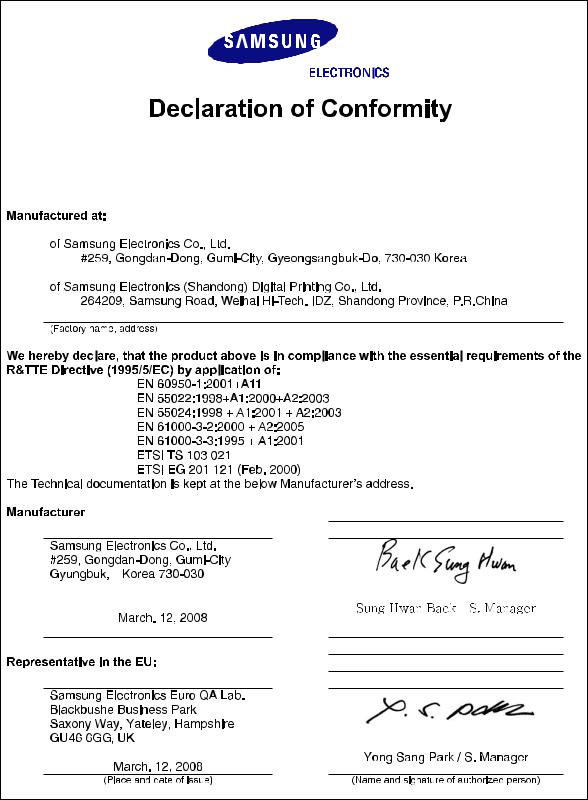
14_Safety information
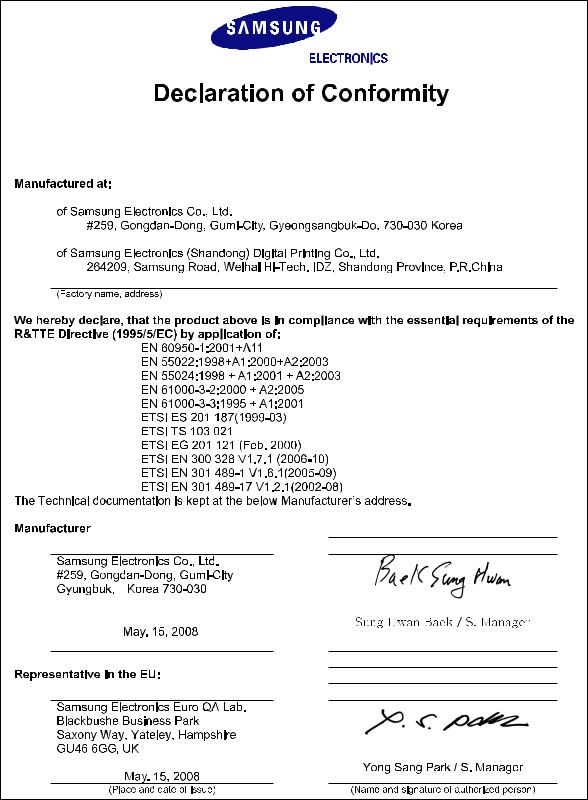
Safety information_15

contents
|
2 |
Features of your new laser product |
|
5 |
Safety information |
INTRODUCTION |
20 |
Machine overview |
20 |
20 |
Front view |
20 |
Rear view |
|
21 |
Control panel overview |
|
|
22 |
Understanding the Status LED |
|
22 |
Acknowledging the status of the toner cartridge |
|
23 |
Menu overview |
|
24 |
Supplied software |
|
24 |
Printer driver features |
|
24 |
Printer driver |
GETTING STARTED
25
LOADING ORIGINALS AND PRINT MEDIA
34
25Setting up the hardware
26System requirements
26 |
Windows |
26 |
Macintosh |
26Linux
27Setting up the network
27 Supported operating environments
27Configuring network protocol via the machine
27Using the SetIP program
28Installing the software
29Using a wireless network(CLX-3175FW only)
30Configuring wireless network from syncthru web service
31Machine's basic settings
31 Altitude adjustment
31Changing the display language
31Setting the date and time
31Changing the clock mode
31Changing the default mode
31Setting sounds
32Entering characters using the number keypad
32Using the save modes
33Auto continue
34Loading originals
34On the scanner glass
34In the ADF
35Selecting print media
36Specifications on print media
37Media sizes supported in each mode
37Guidelines for special print media
38Changing the size of the paper in the paper tray
40Printing on special print materials
40Feeding the print material manually
40Setting the paper size and type
COPYING |
41 |
Copying |
41 |
41 |
Changing the settings for each copy |
41 |
Darkness |
|
41 |
Original Type |
16_Contents

contents
SCANNING
44
BASIC PRINTING
49
FAXING
41Reduced or enlarged copy
42Changing the default copy settings
42ID card copying
42Using special copy features
422-up or 4-up copying
42Poster copying
43Clone copying
43 Erasing background images
43Gray enhance copying
43Setting copy timeout
44Scanning basics
44 Scanning from the control panel
44Setting scan information in Samsung Scan Manager.
44Scanning to application programs
45Scanning by a network connection
45Scanning to Email
46Changing the settings for each scan job
46Changing the default scan settings
46Setting up Address Book
46Registering speed email numbers
46Configuring group email numbers
46Using Address Book entries
46Searching Address Book for an entry
47Printing Address Book
49Printing a document
49Canceling a print job
50Sending a fax
50
50 5051
51
51
51
51
51
52
52
Setting the fax header Adjusting the document settings Sending a fax automatically Sending a fax manually Confirming a transmission Automatic redialing
Redialing the last number
Sending a fax to multiple destinations Sending a delayed fax
Sending a priority fax
53 Receiving a fax
53 Changing receiving modes
53Receiving automatically in Fax mode
53Receiving manually in Tel mode
53Receiving manually using an extension telephone
53Receiving automatically in Ans/Fax mode
53Receiving faxes using DRPD mode
54Receiving in secure receiving mode
54Activating secure receiving mode
54Receiving faxes in memory
54Forwarding faxes
55Fax setup
55 Changing the fax setup options
Contents_17

contents
USING USB MEMORY DEVICE
58
MAINTENANCE
61
TROUBLESHOOTING
70
18_Contents
56 Changing the default document settings
56 Printing sent fax report automatically
56 Setting up Address Book
58 About USB memory
58 Plugging in a USB memory device
58 Scanning to a USB memory device
58Scanning
59Customizing Scan to USB
59 Printing from a USB memory device
59To print a document from a USB memory device:
59Backing up data
59Backing up data
59Restoring data
60Managing USB memory
60 Deleting an image file
60 Formatting a USB memory device
60 Viewing the USB memory status
60Printing directly from a digital camera
61Printing reports
61 Printing a report
61Adjusting the color contrast
62Clearing memory
62 Cleaning your machine
62 Cleaning the outside
62 Cleaning the inside
64Cleaning the scan unit
65Maintaining the cartridge
65Toner cartridge storage
65Expected cartridge life
65Redistributing toner
65Replacing the toner cartridge
66Sending new toner notification
67Replacing the imaging unit
68Replacing the waste toner container
69Maintenance parts
69 Checking replaceables
69Managing your machine from the website
69To access SyncThru™ Web Service:
69Checking the machine’s serial number
70Tips for avoiding paper jams
70Clearing document jams
70Exit misfeed
71Roller misfeed
71Clearing paper jams
71In the tray 1
71In the fuser unit area
72In the paper exit area
74 Understanding display messages
77Solving other problems
77Paper feeding
77Printing problems
78Printing quality problems
80Copying problems
81Scanning problems

contents
|
81 |
Samsung Scan Manager problems |
|
82 |
Fax problems |
|
82 |
Common Windows problems |
|
83 |
Common Linux problems |
|
84 |
Common Macintosh problems |
ORDERING SUPPLIES |
85 |
Supplies |
85 85 |
How to purchase |
|
SPECIFICATIONS |
86 |
General specifications |
86 |
87 |
Printer specifications |
87 |
Scanner specifications |
|
87 |
Copier specifications |
|
|
88 |
Facsimile specifications |
GLOSSARY
89
INDEX
93
CONTACT SAMSUNG WORLDWIDE
95
Contents_19
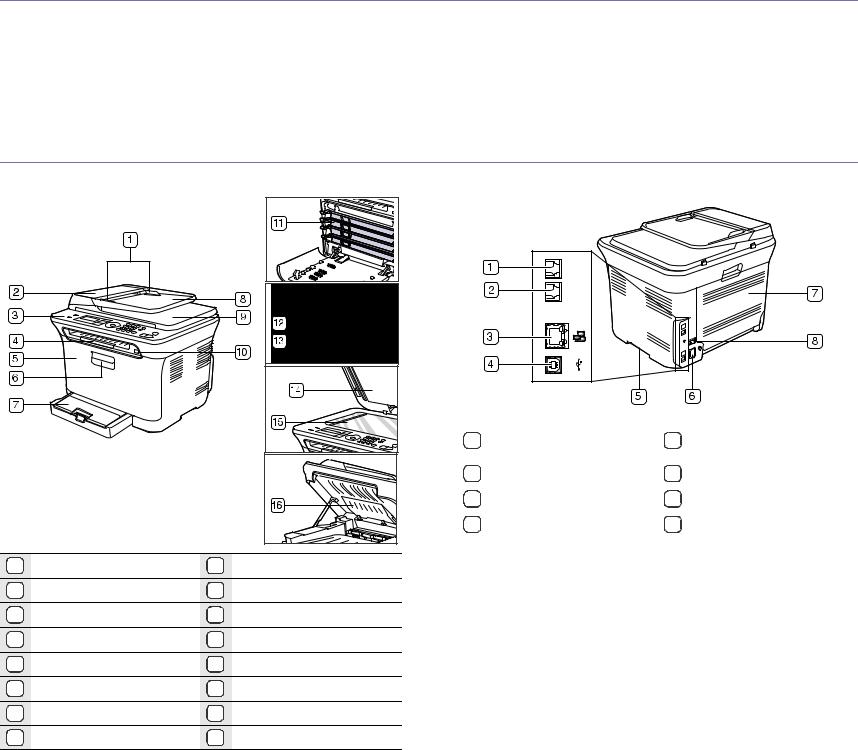
introduction
These are the main components of your machine:
This chapter includes: |
|
|
|
• |
Machine overview |
• |
Menu overview |
• |
Control panel overview |
• |
Supplied software |
• Understanding the Status LED |
• |
Printer driver features |
|
•Acknowledging the status of the toner cartridge
MACHINE OVERVIEW
Front view |
Rear view |
1 |
Document width guides |
9 |
Document output tray |
2 |
ADF |
10 |
USB memory port |
3 |
Control panel |
11 |
Toner cartridge |
4 |
Output support |
12 |
Imaging unit |
5 |
Front cover |
13 |
Waste toner container |
6 |
Front cover handle |
14 |
Scanner lid |
7 |
Tray 1 |
15 |
Scanner glass |
8 |
Document input tray |
16 |
Scan unit |
1 |
Extension telephone socket |
5 |
Handle |
|
(EXT) |
||||
|
|
|
||
|
|
|
|
|
2 |
Telephone line socket |
6 |
Power receptacle |
|
|
|
|
|
|
3 |
Network port |
7 |
Rear cover |
|
|
|
|
|
|
4 |
USB port |
8 |
Power switch |
|
|
|
|
|
20 _Introduction
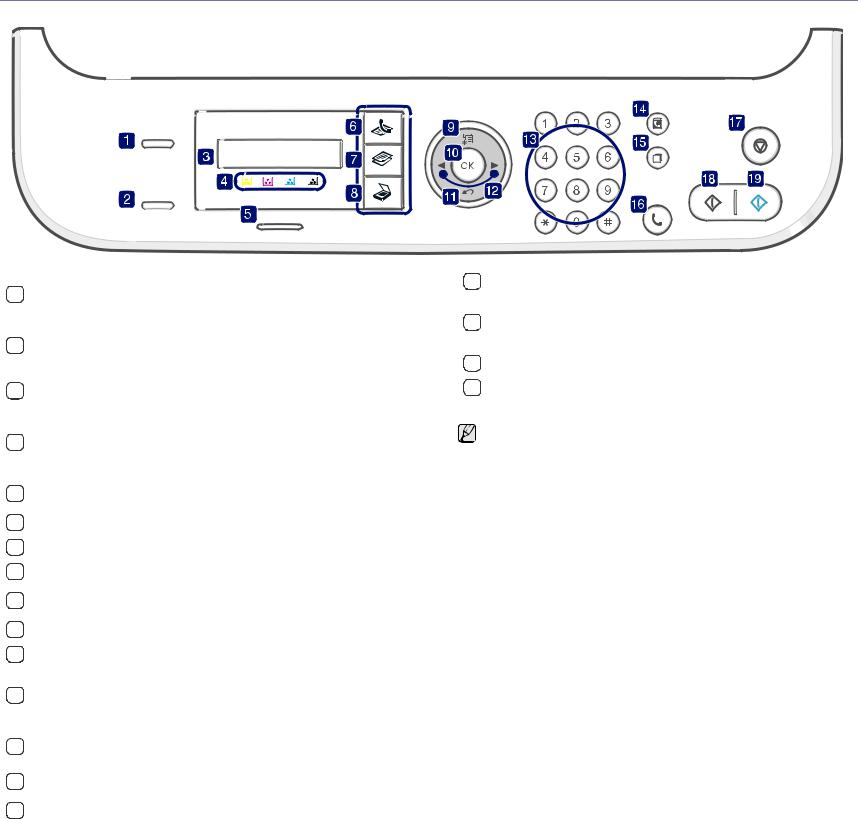
CONTROL PANEL OVERVIEW
|
ID Copy |
You can copy both sides of the ID Card like a |
1 |
driver’s license to a single side of paper. (See "ID |
|
|
|
card copying" on page 42.) |
|
|
Allows you to directly print files stored on a USB |
2 |
Direct USB |
Memory device when it is inserted into the USB |
memory port on the front of your machine. (See |
||
|
|
"About USB memory" on page 58.) |
3 |
Display |
Shows the current status and prompts during an |
operation. |
||
|
|
The toner colors shown below the LCD display |
|
Toner colors |
co-works with the display messages. See Status |
4 |
LED with the toner cartridge messages. (See |
|
|
|
"Acknowledging the status of the toner |
|
|
cartridge" on page 22.) |
5 |
Wirelessa/Status |
Shows the status of your machine. (See |
"Understanding the Status LED" on page 22.) |
||
6 |
Fax |
Activates Fax mode. |
|
|
|
7 |
Copy |
Activates Copy mode. |
|
|
|
8 |
Scan/Email |
Activates Scan mode. |
|
|
|
9 |
Menu |
Enters Menu mode and scrolls through the |
available menus. |
||
10 |
OK |
Confirms the selection on the screen. |
|
|
|
11 |
Back |
Sends you back to the upper menu level. |
|
|
|
|
|
Scroll through the options available in the |
12 |
Left/right arrow |
selected menu, and increase or decrease values. |
When entering characters, use right key to add |
||
|
|
empty space. |
|
Number keypad |
Dials a number or enters alphanumeric |
13 |
characters. (See "Keypad letters and |
|
|
|
numbers" on page 32.) |
14 |
Address Book |
Allows you to search for stored email addresses. |
|
|
|
15 |
Redial/Pause |
In ready mode, redials the last number, or in Edit |
mode, inserts a pause into a fax number. |
||
|
|
|
16 |
On Hook Dial |
Engages the telephone line. |
|
|
|
|
|
Stops an operation at any time. In ready mode, |
17 |
Stop/Clear |
clears/cancels the copy options, such as the |
darkness, the document type setting, the copy |
||
|
|
size, and the number of copies. |
18 |
Black Start |
Starts a job in Black and White mode. |
|
|
|
19 |
Color Start |
Starts a job in Color mode. |
|
|
|
a. CLX-3175FW only.
• All illustrations on this user’s guide may differ from your machine depending on its options or models.
•The surface of the output tray may become hot if you print a large number of pages at once. Make sure that you do not touch the surface, and do not allow children near it.
Introduction_ 21
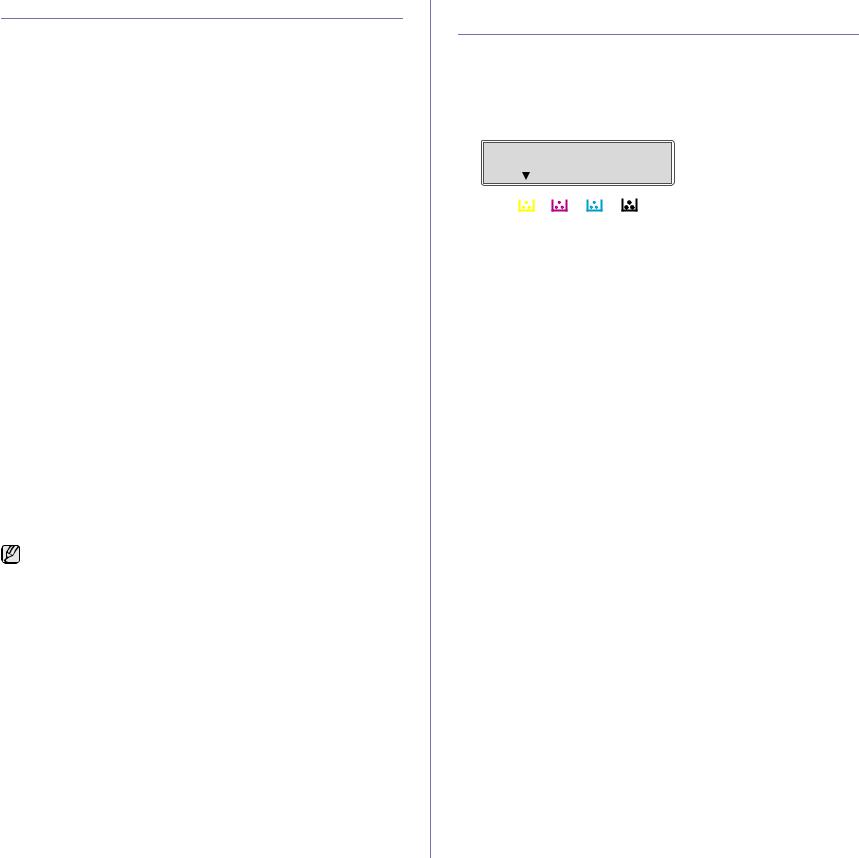
UNDERSTANDING THE STATUS LED
The color of the Status LED indicates the machine's current status.
STATUS |
DESCRIPTION |
|
|
|
|
Off |
|
• The machine is powered off-line. |
|
|
• The machine is in power save mode. When |
|
|
data is received, or any button is pressed, it |
|
|
switches to on-line automatically. |
|
|
• Wireless function can not be used. |
|
|
|
Green |
Blinking |
• When the green LED slowly blinks, the |
|
|
machine is receiving data from the computer. |
|
|
• When the green LED rapidly brinks, the |
|
|
machine is printing data. |
|
|
|
|
On |
• The machine is powered on and can be used. |
|
|
• Wireless function can be used. |
Red |
Blinking |
• A minor error has occurred and the machine is |
|
|
waiting for the error to be cleared. Check the |
|
|
display message, and solve the problem |
|
|
referring to "Understanding display |
|
|
messages" on page 74. |
|
|
• The toner cartridge is low. Order a new toner |
|
|
cartridge, see "Ordering supplies" on page 85. |
|
|
You can temporarily improve print quality by |
|
|
redistributing the toner. (See "Replacing the |
|
|
toner cartridge" on page 65.) |
|
|
|
|
On |
• A problem has occurred such as a paper jam, |
|
|
cover is open or no paper in the tray, so that |
|
|
the machine cannot continue the job. Check |
|
|
the message on the display, and refer to |
|
|
"Understanding display messages" on |
|
|
page 74 to solve the problem. |
|
|
• The toner cartridge is empty, exhausted, or |
|
|
needs to be changed. (See "Understanding |
|
|
display messages" on page 74.) |
|
|
|
Always check the message on the display to solve the problem. The instruction in the Troubleshooting section will guide you to operate the machine properly. See "Understanding display messages" on page 74 for more information.
ACKNOWLEDGING THE STATUS OF THE TONER CARTRIDGE
The status of toner cartridges is indicated by the Status LED and the LCD display. If the toner cartridge is low or needs to be replaced, the Status LED turns red and the display shows the message. However the arrow mark shows which color toner is of concern or may be installed with a new cartridge.
Example:
The above example shows the yellow cartridge status indicated by the arrow. Check the message to find out what the problem is and how to solve it. See "Understanding display messages" on page 74 to browse the detailed information on error messages.
22 _Introduction
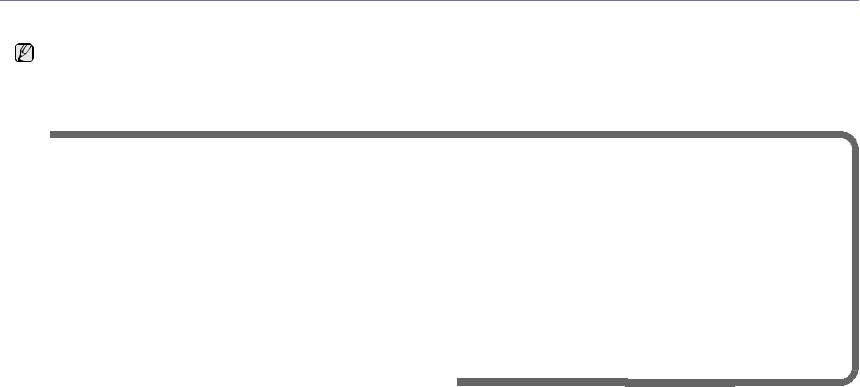
MENU OVERVIEW
The control panel provides access to various menus to set up the machine or use the machine’s functions. These menus can be accessed by pressing Menu. Refer to the following diagram.
Some menus may not appear in the display depending on options or models. If so, it is not applicable to your machine.
.
Fax Feature |
|
Fax Setup |
|
Fax Setup |
|
Copy Feature |
|
Copy Setup |
|
Scan Feature |
|
Scan Setup |
|
|
|
|
(Continued) |
|
|
|
|
|
|
|
|
Darkness |
|
Sending |
|
Stamp RCV Name |
|
Reduce/Enlarge |
|
Change Default |
|
USB feature |
|
Change Default |
Resolution |
|
Redial Times |
|
RCV Start Code |
|
Darkness |
|
Copies |
|
Scan Size |
|
USB Default |
Multi Send |
|
Redial Term |
|
Auto Reduction |
|
Original Type |
|
Copy Collation |
|
Original Type |
|
E-mail Default |
Delay Send |
|
Prefix Dial |
|
Discard Size |
|
Layout |
|
Reduce/Enlarge |
|
Resolution |
|
|
Priority Send |
|
ECM Mode |
|
Junk Fax Setup |
|
Adjust Bkgd. |
|
Darkness |
|
Scan Color |
|
|
Forward |
|
Send Report |
|
DRPD Mode |
|
Gray Enhance |
|
Original Type |
|
Scan Format |
|
|
Secure Receive |
|
Image TCR |
|
Change Default |
|
|
|
|
|
E-mail Feature |
|
|
Add Page |
|
Dial Mode |
|
Resolution |
|
|
|
|
|
Scan Size |
|
|
Cancel Job |
|
Receiving |
|
Darkness |
|
|
|
|
|
Original Type |
|
|
|
|
Receive Mode |
|
Auto Report |
|
|
|
|
|
Resolution |
|
|
|
|
Ring to Answer |
|
|
|
|
|
|
|
Scan Color |
|
|
|
|
|
|
|
|
|
|
|
|
|||
|
|
|
|
|
|
|
|
|
|
|
|
|
Network |
|
|
System Setup |
|
System Setup |
|
System Setup |
|
|
|
(Continued) |
|
(Continued) |
|
|
TCP/IP |
|
|
Clear Setting |
|
Report |
|
Machine Setup |
Ethernet Speed |
|
|
All Settings |
|
All Report |
|
Machine ID |
Wirelessa |
|
|
Fax Setup |
|
Configuration |
|
Machine Fax No. |
Clear Setting |
|
|
Copy Setup |
|
Supplies Info |
|
Date & Time |
Network Info |
|
|
Scan Setup |
|
Address Book |
|
Clock Mode |
|
|
|
System Setup |
|
Send Report |
|
Language |
a.CLX-3175FW |
|
|
|
||||
|
|
Network Setup |
|
Sent Report |
|
Default Mode |
|
only |
|
|
Address Book |
|
Fax RCV Report |
|
Power Save |
|
|
|
Sent Report |
|
Schedule Jobs |
|
Timeout |
|
|
|
Fax RCV Report |
|
JunkFax Report |
|
Altitude Adj. |
|
|
|
|
|
Network Info. |
|
Auto Continue |
|
|
|
|
|
User Auth List |
|
Import Setting |
|
|
|
|
|
Maintenance |
|
Export Setting |
|
|
|
|
|
CLR Empty Msg |
|
Paper Setup |
|
|
|
|
|
Supplies Life |
|
Paper Size |
|
|
|
|
|
Color |
|
Paper Type |
|
|
|
|
|
Serial Number |
|
Sound/Volume |
|
|
|
|
|
|
|
Key Sound |
|
|
|
|
|
|
|
Alarm Sound |
|
|
|
|
|
|
|
Speaker |
|
|
|
|
|
|
|
Ringer |
23 _Introduction
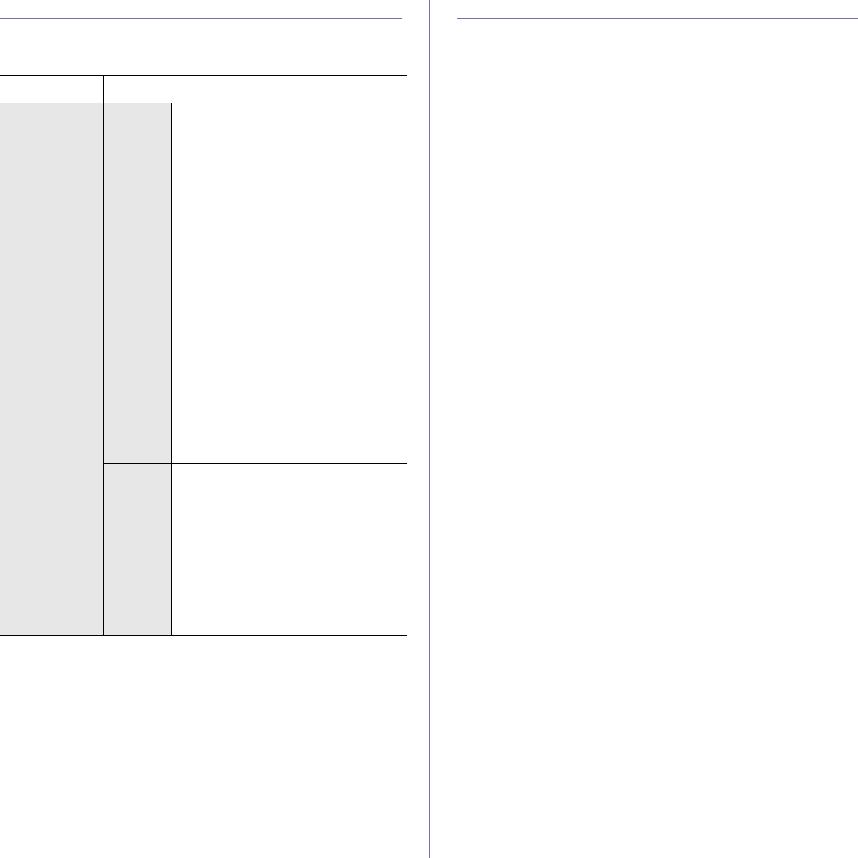
SUPPLIED SOFTWARE
You must install the machine software using the supplied CD to use your machine as a printer and a scanner, after you have set up your machine and connected it to your computer. CD provides you with the following software.
CD |
|
CONTENTS |
|
|
|
Printer |
Windows |
• Printer driver: Use this driver to take full |
software CD |
|
advantage of your printer’s features. |
|
|
• Scanner driver: TWAIN and Windows |
|
|
Image Acquisition (WIA) drivers are |
|
|
available for scanning documents on |
|
|
your machine. |
|
|
• Smart Panel: This program allows you to |
|
|
monitor the machine’s status and alerts |
|
|
you when an error occurs during printing. |
|
|
• SmarThrua: This is the accompanying |
|
|
Windows-based software for your |
|
|
multifunctional machine. |
|
|
• SetIP: Use this program to set your |
|
|
machine’s TCP/IP addresses. |
|
|
|
|
Linux |
• Printer driver: Use this driver to run |
|
|
your machine from a Linux computer |
|
|
and print documents. |
|
|
• SANE: Use this driver to scan |
|
|
documents. |
|
|
• Smart Panel: This program allows you |
|
|
to monitor the machine’s status and |
|
|
alerts you when an error occurs during |
|
|
printing. |
|
|
• SetIP: Use this program to set your |
|
|
machine’s TCP/IP addresses. |
Macintosh • Printer driver: Use this driver to take full advantage of your printer’s features.
•Scanner driver: TWAIN driver is available for scanning documents on your machine.
•Smart Panel: This program allows you to monitor the machine’s status and alerts you when an error occurs during printing.
•SetIP: Use this program to set your machine’s TCP/IP addresses.
a.Allows you to edit a scanned image in many ways using a powerful image editor and to send the image by email. You can also open another image editor program, like Adobe Photoshop, from SmarThru. For details, refer to the onscreen help supplied on the SmarThru program.
PRINTER DRIVER FEATURES
Your printer drivers support the following standard features:
•Paper orientation, size, source and media type selection
•Number of copies
In addition, you can use various special printing features. The following table shows a general overview of features supported by your printer drivers:
Printer driver
FEATURE |
WINDOWS |
LINUX |
MACINTOSH |
|
|
|
|
Color mode |
O |
O |
O |
|
|
|
|
Machine quality option |
O |
O |
O |
|
|
|
|
Poster printing |
O |
X |
X |
|
|
|
|
Multiple pages per sheet |
O |
O (2, 4) |
O |
(N-up) |
|
|
|
Fit to page printing |
O |
X |
Oa |
Scale printing |
O |
X |
O |
|
|
|
|
Watermark |
O |
X |
X |
|
|
|
|
Overlay |
O |
X |
X |
|
|
|
|
a.This feature is supported only MAC OS X 10.4 ~ 10.5.
24 _Introduction

getting started
This chapter gives you step-by-step instructions for setting up the machine.
This chapter includes:
•Setting up the hardware
•System requirements
•Setting up the network
SETTING UP THE HARDWARE
This section shows the steps to set up the hardware which is explained in the Quick Install Guide. Make sure you read Quick Install Guide and complete following steps.
1.Select a stable location.
Select a level, stable place with adequate space for air circulation. Allow extra space to open covers and trays.
The area should be well-ventilated and away from direct sunlight or sources of heat, cold, and humidity. Do not set the machine close to the edge of your desk or table.
•Installing the software
•Using a wireless network(CLX-3175FW only)
•Machine's basic settings
3.Remove the tape holding the machine tightly.
4.Load paper.
5.Make sure that all the cables are connected to the machine.
6.Turn the machine on.
When you move the machine, do not tilt or turn it upside down. Otherwise, the inside of the machine may be contaminated by toner, which can cause damage to the machine or bad print quality.
Printing is suitable for altitudes under 1,000 m (3,281 ft). Refer to the altitude setting to optimize your printing. See "Altitude adjustment" on page 31 for more information.
Place the machine on a flat, stable surface so that there is no incline greater than 2 mm (0.08 inch). Otherwise, printing quality may be affected.
2. Unpack the machine and check all the enclosed items.
25 _Getting started
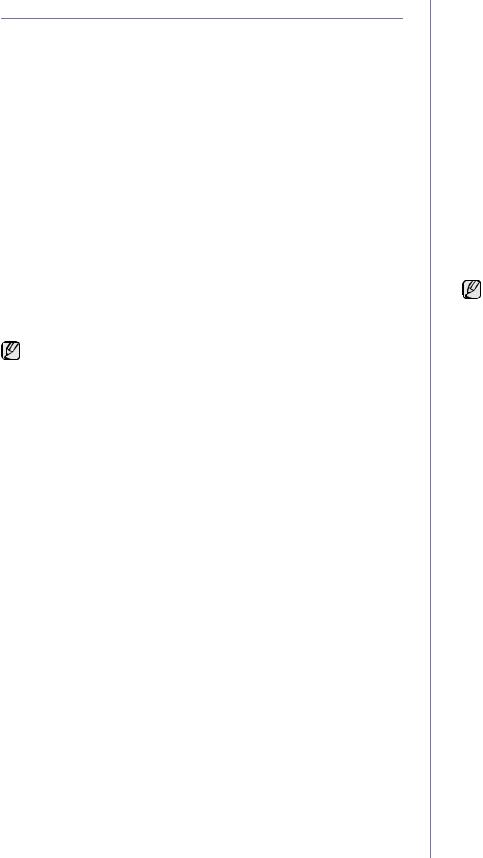
SYSTEM REQUIREMENTS
Before you begin, ensure that your system meets the following requirements:
Windows
Your machine supports the following Windows operating systems.
OPERATING |
REQUIREMENT (RECOMMENDED) |
||
|
|
|
|
|
|
|
|
SYSTEM |
CPU |
RAM |
FREE HDD |
|
SPACE |
||
|
|
|
|
Windows |
Pentium II 400 MHz |
128 MB |
600 MB |
2000 |
(Pentium III 933 MHz) |
(256 MB) |
|
|
|
|
|
Windows XP |
Pentium III 933 MHz |
128 MB |
1.5 GB |
|
(Pentium IV 1 GHz) |
(256 MB) |
|
Windows |
Pentium III 933 MHz |
128 MB |
1.25 GB to |
2003 Server |
(Pentium IV 1 GHz) |
(512 MB) |
2 GB |
Windows |
Pentium IV 3 GHz |
512 MB |
15 GB |
Vista |
|
(1024 MB) |
|
|
|
|
|
• Internet Explorer 6.0 or higher is the minimum requirement for all Windows operating systems.
•Users who have an administrator right can install the software.
Macintosh
|
|
REQUIREMENT (RECOMMENDED) |
||
OPERATING |
|
|
|
|
|
|
|
FREE |
|
SYSTEM |
|
|
|
|
|
CPU |
RAM |
HDD |
|
|
|
|||
|
|
|
|
SPACE |
|
|
|
|
|
Mac OS X |
• |
Intel Processor |
• 128 MB for a |
1 GB |
10.3 ~ 10.4 |
• |
Power PC G4 / |
Power-PC |
|
|
|
G5 |
based Mac (512 |
|
|
|
|
MB). |
|
|
|
|
• 512 MB for an |
|
|
|
|
Intel-based Mac |
|
|
|
|
(1 GB) |
|
|
|
|
|
|
Mac OS X 10.5 |
• |
Intel Processor |
512 MB (1 GB) |
1 GB |
|
• |
867 MHz or |
|
|
|
|
faster Power |
|
|
|
|
PC G4 /G5 |
|
|
|
|
|
|
|
Linux
ITEM |
REQUIREMENTS |
|
|
Operating system |
RedHat 8.0, 9.0 (32bit) |
|
RedHat Enterprise Linux WS 4, 5 (32/64bit) |
|
Fedora Core 1~7 (32/64bit) |
|
Mandrake 9.2 (32bit), 10.0, 10.1 (32/64bit) |
|
Mandriva 2005, 2006, 2007 (32/64bit) |
|
SuSE Linux 8.2, 9.0, 9.1 (32bit) |
|
SuSE Linux 9.2, 9.3, 10.0, 10.1, 10.2 (32/64bit) |
|
SuSE Linux Enterprise Desktop 9, 10 (32/64bit) |
|
Ubuntu 6.06, 6.10, 7.04 (32/64bit) |
|
Debian 3.1, 4.0 (32/64bit) |
CPU |
Pentium IV 2.4GHz (IntelCore2) |
|
|
RAM |
512 MB (1024 MB) |
|
|
Free HDD space |
1 GB (2GB) |
|
|
• It is necessary to claim swap partition of 300 MB or larger for working with large scanned images.
•The Linux scanner driver supports the optical resolution at maximum.
26 _Getting started
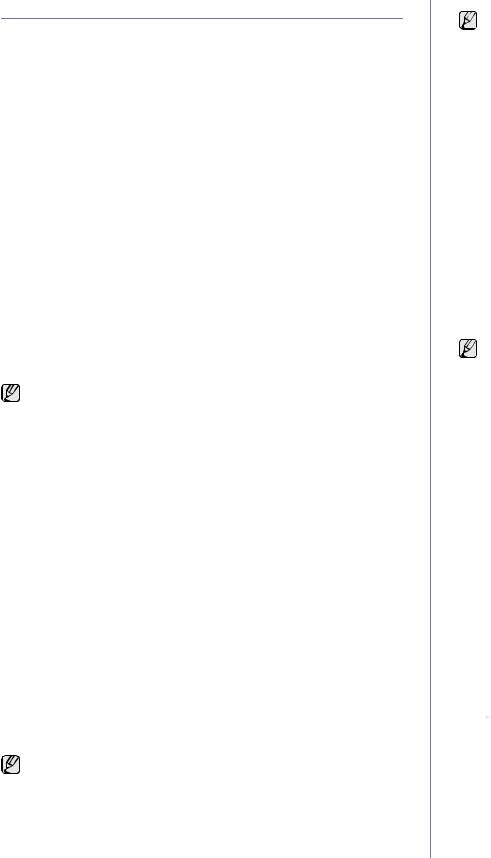
SETTING UP THE NETWORK
You need to set up the network protocols on the machine to use it in the network environment. You can set up the basic network settings through the machine's control panel.
Supported operating environments
The following table shows the network environments supported by the machine:
ITEM |
|
REQUIREMENTS |
|
|
|
Network interface |
• |
Ethernet 10/100 Base-TX |
|
• 802.11 b/g Wireless LAN |
|
|
|
(CLX-3175FW only) |
|
|
|
Network operating system |
• |
Windows 2000/XP/2003/Vista |
|
• |
Various Linux OS |
|
• MAC OS 10.3 ~ 10.5 |
|
|
|
|
Network protocols |
• |
TCP/IP |
|
• |
Standard TCP/IP |
|
• |
LPR |
|
• |
IPP/HTTP |
|
• |
Bonjour |
|
• |
DHCP |
|
• |
BOOTP |
|
|
|
If you are in a non-static IP address environment and need to setup a DHCP network protocol, go to the http://developer.apple.com/ networking/bonjour/download/, select the program Bonjour for Windows due to your computer operating system, and install the program. This program will allow you to fix the network parameter automatically. Follow the instruction in the installation window. This
Bonjour program does not support Linux.
Configuring network protocol via the machine
You can set up TCP/IP network parameters, follow the steps listed below.
1.Make sure your machine is connected to the network with an RJ-45 Ethernet cable.
2.Make sure you have turned on the machine.
3.Press Menu on the control panel, until you see Network on the bottom line of the display and press OK.
4.Press the left/right arrow until TCP/IP appears and press OK.
5.Press the left/right arrow until Static appears and press OK.
6.Press the left/right arrow until IP Address appears and press OK.
Enter a byte between 0 and 255 using the number keypad and press the left/right arrow to move between bytes.
Repeat this to complete the address from the 1st byte to the 4th byte.
7.When you have finished, press OK.
Repeat steps 6 and 7 to configure the other TCP/IP parameters: subnet mask and gateway address.
Contact the network administrator if you are not sure how to configure.
You can also set up the network settings through the network administration programs.
•SyncThru™ Web Admin Service: Web-based printer management solution for network administrators. SyncThru™ Web Admin Service provides you with an efficient way of managing network devices and lets you remotely monitor and troubleshoot network machines from any site with corporate
internet access. Download this program from http:// solution.samsungprinter.com.
•SyncThru™ Web Service: Web server embedded on your network print server, which allows you to:
-Configure the network parameters necessary for the machine to connect to various network environments.
-Customize machine settings.
•SetIP: Utility program allowing you to select a network interface and manually configure the IP addresses for use with the TCP/IP protocol. (See "Using the SetIP program" on page 27.)
Using the SetIP program
This program is for the network IP setting using the MAC address which is the hardware serial number of the network printer card or interface. Especially, it helps the network administrator set several network IPs at the
same time.
• You can only use SetIP program when your machine is connected to a network.
•The following procedure is based on windows XP. If you use Macintosh or Linux OS, see Software section
Installing the program
1.Insert the driver CD provided along with your machine. When the driver CD runs automatically, close the window.
2.Start Windows Explorer and open the X drive. (X represents your CDROM drive.)
3.Double-click Application > SetIP.
4.Double-click Setup.exe to install this program.
5.Click OK.
If necessary, select a language from the drop-down list.
6.Follow the instructions in the window and complete the installation.
Setting network values
1.Print the machine’s network configuration report to find your machine’s MAC address. See "Printing reports" on page 61.
2.From the Windows Start menu, select All Programs > Samsung Network Printer Utilities > SetIP > SetIP.
3.Click  to open the TCP/IP configuration window.
to open the TCP/IP configuration window.
4.Enter the network card's MAC address, IP address, subnet mask, default gateway, and then click Apply.
 when you enter the MAC address, enter it without colon(:).
when you enter the MAC address, enter it without colon(:).
5.Click OK, then the machine prints the network information. Confirm the settings are correct.
6.Click Exit.
Getting started_ 27
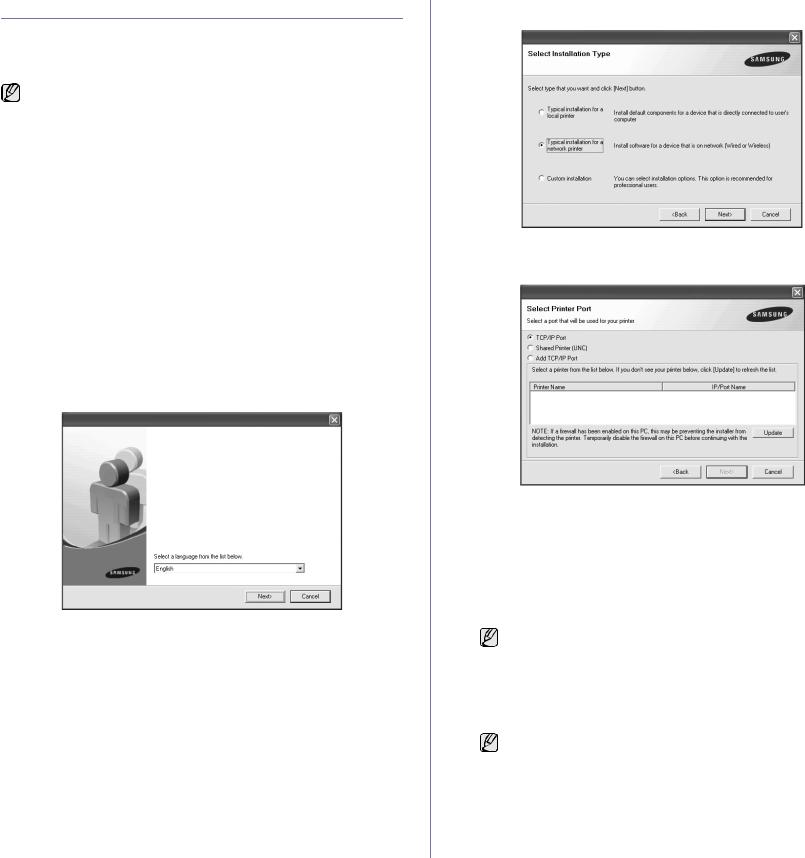
INSTALLING THE SOFTWARE
You have to install the machine software for printing. The software includes drivers, applications, and other user friendly programs.
The following procedure is based on Windows XP. If you use Macintosh or Linux OS, see Software section.
• The following procedure is for when the machine is being used as a network machine. If you want to connect a machine with a USB cable, refer to Software section.
•The procedure and popup window which appear during the installation may differ depending on the operating system, the printer feature, or the interface in use.
1.Connect the network cable to your machine.
2.Make sure that the network setup for your machine is completed. (See "Setting up the network" on page 27.) All applications should be closed on your computer before beginning installation.
3.Insert the Printer Software CD-ROM into your CD-ROM drive.
The CD-ROM should automatically run, and an installation window appears.
If the installation window does not appear, click Start > Run. Type X:\Setup.exe, replacing “X” with the letter which represents your drive and click OK.
If you use Windows Vista, click Start > All Programs > Accessories >
Run, and type X:\Setup.exe.
If the AutoPlay window appears in Windows Vista, click Run Setup.exe in Install or run program field, and click Continue in the User Account Control window.
4.Click Next.
•The window above may slightly differ, if you are reinstalling the driver.
5. Select Typical installation for a network printer, and then click Next.
6.The list of machines available on the network appears. Select the printer you want to install from the list and then click Next.
•If you do not see your machine on the list, click Update to refresh the list, or select Add TCP/IP Port to add your machine to the network. To add the machine to the network, enter the port name and the IP address for the machine.
To verify your machine’s IP address or the MAC address, print a Network Configuration page. (See "Printing reports" on page 61.)
•To find a shared network printer (UNC Path), select Shared Printer [UNC] and enter the shared name manually or find a shared printer by clicking the Browse button.
If you are not sure of the IP address, contact your network administrator or print network information. (See "Printing reports" on page 61.)
7.After the installation is finished, a window appears asking you to print a test page and to register yourself as a user of Samsung machines in order to receive information from Samsung. If you wish to do so, select the corresponding checkbox(es) and click Finish.
• If your machine does not work properly after the installation, try to reinstall the printer driver. See Software section.
•During the printer driver installation process, the driver installer detects the location information for your operating system and sets the default paper size for your machine. If you use a different Windows location, you must change the paper size to match the paper you usually use. Go to printer properties to change the paper size after installation is complete.
28 _Getting started
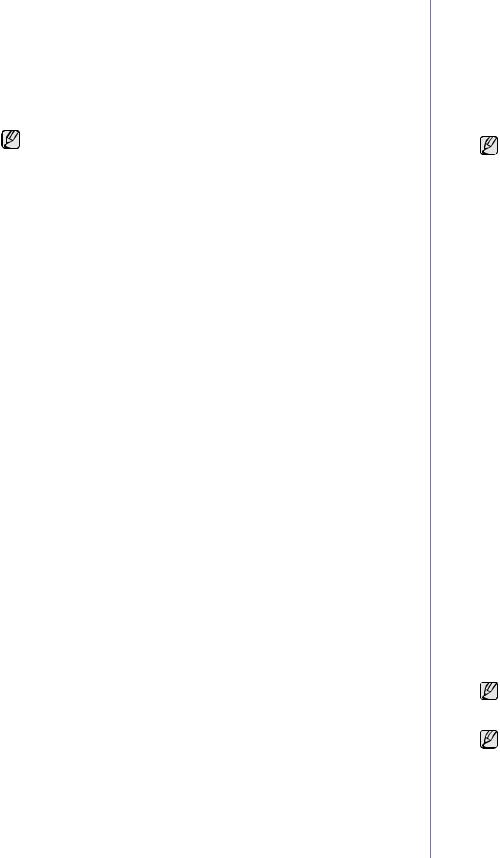
USING A WIRELESS NETWORK(CLX-3175FW ONLY)
You must configure the appropriate network parameters to use your printer in a wireless network. To do this, you can use both control panel and SyncThru Web Service, an embedded web site of your printer. This section gives you basic information on 802.11b/g network parameters which can be configured from the control panel.
You can retrieve basic settings by selecting a wireless network or manually configure them as you need.
If you do not know about your wireless environment, please ask the network administrator.
1.Press Menu on the control panel until you see Network on the bottom line of the display and press OK.
2.Press the left/right arrow until Wireless appears and press OK.
3.Press the left/right arrow until WLAN Setting appears and press OK.
4.Press the left/right arrow to select the setup method you want appears and press OK.
•Wizard: The wireless network interface card in your printer searches for wireless networks in the area and shows the results.
•Custom: You can configure the wireless settings according to your needs.
Wizard mode
1.The wireless network interface card on your machine searches for wireless network in the area and shows the results.
2.Press the left/right arrow to select a network you want to use in Search List and press OK.
3.When WLAN Security None appears on the display, press OK to save your selection. go to step 6.
If you see another messages, go on to the next step.
4.According to the network you select, WLAN security encryption type will be WEP or WPA.
•In case of WEP, Press the left/right arrow to selcet Open System or
SharedKey.
-Open System: Authentication is not used, and Encryption may or may not be used, depending on the need for data security. Enter the WEP Key using alphanumeric after selecting Open System.
-SharedKey: Authentication is used. A device that has a proper WEP Key can access the network. Enter the WEP Key using alphanumeric after selecting SharedKey.
Key |
HEXADECIMAL FORMAT |
ASCII FORMAT |
|
|
|
64-bit WEP |
10 digits (0 ~9, A~F) |
5 Alphanumeric |
|
|
characters |
|
|
|
128-bit WEP |
26 digits (0 ~9, A~F) |
13 Alphanumeric |
|
|
characters |
|
|
|
•In case of WPA, Enter the WPA Key using alphanumerics. The Key length should be between 8 to 63 characters long.
5.Press OK.
6.Press Stop/Clear to return to ready mode.
Custom mode
1.Press OK when Edit SSID appears on the bottom line of the display.
2.Enter the SSID when Edit SSID appears on the top line of the display, the name that identifies a wireless network. SSID is case-sensitive so you need to enter it carefully. Press OK.
3.Select the type of wireless connections. Press the left/right arrow to select the method of Operation Mode you want and press OK.
•Ad-hoc: Allows wireless devices to communicate directly with each other in a peer-to-peer environment. Go to step 4.
In Ad-Hoc mode, even if the network cable is connected, your printer will use the wireless interface.
•Infrastructure: Allows wireless devices to communicate with each other through an access point. Go to step 5.
4.Press the left/right arrow to select the method of Channel you want and press OK. If you select Auto, the wireless network interface card on your machine will automatically adjust the channels.
5.Press the left/right arrow to select the method of WLAN Security you want and press OK.
•None: This is used when the validation of a wireless device’s identity and data encryption are not required for your network. Open system is used for IEEE 802.11 authentication.
•Static WEP: This uses the WEP (Wired Equivalent Privacy) algorithm suggested by IEEE 802.11 standard for security. Static WEP security mode requires a proper WEP key for data encryption, decryption, and IEEE 802.11 authentication. Press the left/right arrow to select the setup method you want in Authentication and press OK.
-Open System: Authentication is not used, and encryption may or may not be used, depending on the need for data security. Enter the WEP Key using alphanumeric after select Open System and then press OK.
-SharedKey: Authentication is used. A device that has a proper WEP key can access the network. Enter the WEP Key using alphanumeric after selecting SharedKey and then press OK.
•WPA-PSK or WPA2-PSK: You can select WPA-PSK or WPA2-PSK to authenticate the print server based on WPA Pre-Shared Key. This uses a shared secret key (generally called Pre Shared Key passphrase) that is manually configured on the access point and each of its clients. This is suitable for users who want to use WPA but do not have a RADIUS server installed on their network.
a.Press OK when WPA-PSK or WPA2-PSK appears on the bottom line of the display.
b.Press the left/right arrow to select TKIP or AES in Encryption and press OK. If you select WPA2-PSK, press the left/right arrow to select AES or TKIP + AES in Encryption and press OK.
c.Enter the WPA Key using alphanumeric and press OK.
WPA-PSK or WPA2-PSK are not displayed In Ad-Hoc mode.
6. When you have finished, press Stop/Clear to return to the ready mode.
If you select Infrastructure in Operation Mode, you must disconnect the network cable to activate wireless network after completing the network setting.
Getting started_ 29
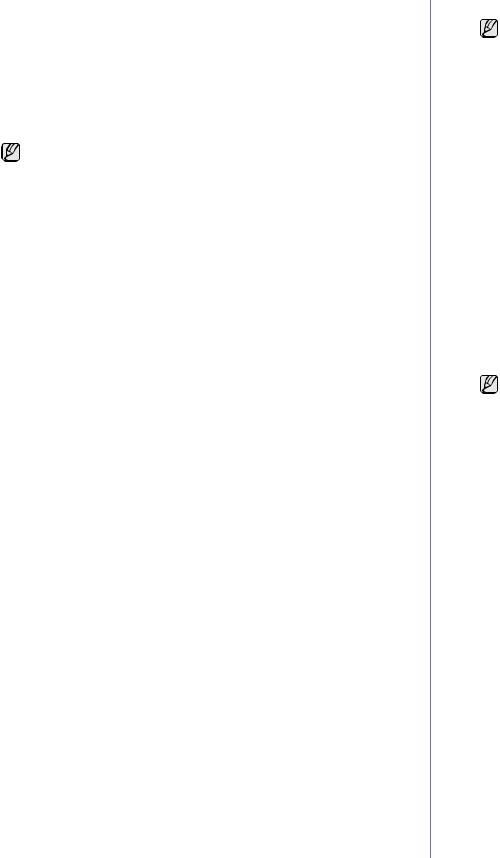
Configuring wireless network from syncthru web service
You must configure the appropriate network parameters to use your printer in a wireless network. You can use SyncThru™ Web Service, an embedded web site of your printer. This section gives you basic information on 802.11b/g network parameters which can be configured from the
SyncThru™ Web Service.
You can configure basic wireless settings, such as SSID, Operation Mode and WPA Shared Key. You can retrieve basic settings by selecting a wireless network.
If you do not know about your wireless environment, please ask the network administrator.
Wizard mode
1.Prior to wireless network settings, you should set IP address for the machine first. See "Using the SetIP program" on page 27.
2.Enter your machine’s IP address as the URL in a browser and click Go to access the web site of your machine.
3.Click Network Settings and Wireless.
4.Select Wizard in Wireless Settings.
5.Click Next.
6.Select Network Name(SSID) in SSID Setup.
•SSID: SSID(Service Set Identifier) is a name that identifies a wireless network. Access points and wireless devices attempting to connect to a specific wireless network must use the same SSID. The SSID is case-sensitive.
•Operation Mode: Operation Mode refers to the type of wireless connections.
-Ad-hoc: allows wireless devices to communicate directly with each other in a peer-to-peer environment.
-Infrastructure: allows wireless devices to communicate with each other through an access point.
7.Click Next.
If wireless security setting window appears, enter the registered password and click Next.
•Operation Mode is Infrastructure:
-None: This is used when the validation of a wireless device’s identity and data encryption are not required for your network. Open system is used for IEEE 802.11 authentication.
-Static WEP: This uses the WEP (Wired Equivalent Privacy) algorithm suggested by IEEE 802.11 standard for security. Static WEP security mode requires a proper WEP key for data encryption, decryption, and IEEE 802.11 authentication.
-WPA Personal: You can select WPA-PSK to authenticate the print server based on WPA Pre-Shared Key. This uses a shared secret key (generally called Pre Shared Key passphrase) that is manually configured on the access point and each of its clients. This is suitable for users who want to use WPA but do not have a RADIUS server installed on their network.
•Operation Mode is Ad-hoc:
-None: This is used when the validation of a wireless device’s identity and data encryption are not required for your network. Open system is used for IEEE 802.11 authentication.
-Static WEP: This uses the WEP (Wired Equivalent Privacy) algorithm suggested by IEEE 802.11 standard for security. Static WEP security mode requires a proper WEP key for data encryption, decryption, and IEEE 802.11 authentication.
8.Wizard Setup Confirmation window appears, please check your wireless setup. If the setup is right, click Apply.
9. Click OK.
If Operation Mode of Network Name(SSID) is Infrastructure, you must disconnect the network cable to activate wireless network after completing the network setting.
Custom mode
1.Enter your machine’s IP address as the URL in a browser and click Go to access the web site of your machine.
2.Click Network Settings and Wireless.
3.Select Custom in Wireless Settings.
4.Click Next.
5.Select SSID in Search List. If you cannot find SSID you want, click Refresh, or Enter SSID you want after selecting Insert New SSID.
6.Select Operation Mode from the drop-down list.
If you select Ad-hoc in Operation Mode, select Ad-hoc Channel. If you select Auto Setting, the wireless network interface card on your machine will automatically adjust the channels.
7.Select Authentication from the drop-down list.
8.Select Encryption from the drop-down list.
9.You might need to configure the Network Key Setup depending on the set value of Network Setup or Security Setup.
10.Click Next.
11.Wireless Setup Confirmation window appears, please check your wireless setup. If the setup is right, click Apply.
12.Click OK.
If Operation Mode of Network Name(SSID) is Infrastructure, you must disconnect the network cable to activate wireless network after completing the network setting.
30 _Getting started
